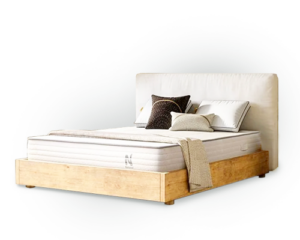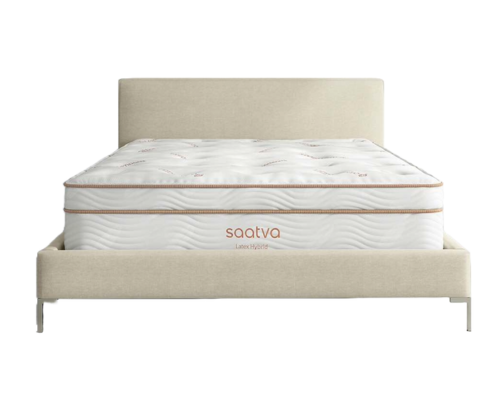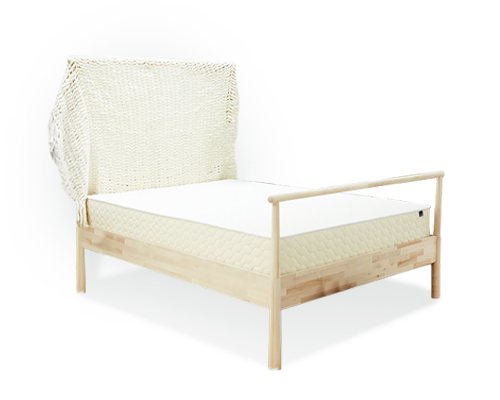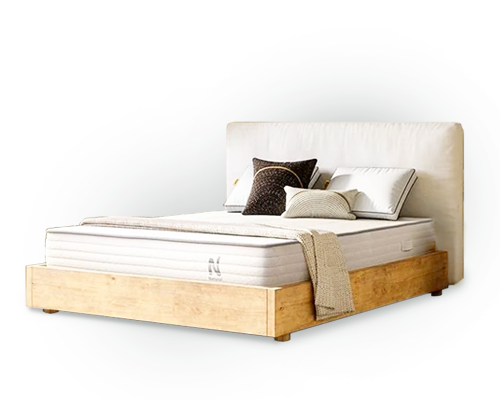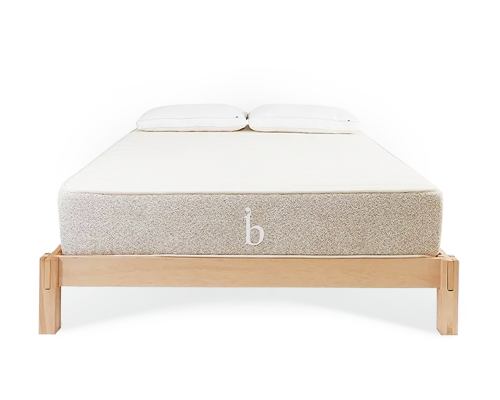- Price: $2,395 for a queen before discounts
- Material: Hybrid latex
- Brand’s firmness rating: Firm
- Mattress height: 12″
- Trial period: 365 nights
- Shipping: Free with glove delivery
- Warranty: Lifetime warranty
- Offers financing: Yes, using Affirm
5 Best Hypoallergenic Mattresses for Allergies in 2025 | Hand-Tested by Experts
Key Takeaways
- We selected the Saatva Latex Hybrid as the “Best Mattress for Allergies” due to its natural, organic materials, and mattress cover, which has undergone plant-based antimicrobial treatment.
- Our top hypoallergenic mattress picks range from $936–$3,398, but most brands offer discounts and promotions throughout the year.
- The right bedding and pillows also help create a more allergy-free environment for sleepers. Choose sheets and comforters made from natural cotton, bamboo, or linen fibers, and avoid down-filled pillows and comforters.
Your bedroom should be your sanctuary—it shouldn’t trigger a runny nose, watery eyes, sneezing, or coughing. But if you have allergies, chemical sensitivities, or are one of the 8% of U.S. adults with asthma, your current mattress may be preventing you from getting a restful sleep [1] Centers for Disease Control and Prevention. Most Recent National Asthma Data. May 10, 2023. Found on the internet at https://www.cdc.gov/asthma/most_recent_national_asthma_data.htm .
Mattresses can harbor common allergens like dust mites, mold, mildew, and pet dander, which can irritate allergies or trigger asthma attacks. Even some of the best mattresses may contain chemicals and synthetic materials that can irritate sleepers.
“Look for mattresses that contain organic or natural materials, such as latex, organic wool, and cotton,” said Mohammad A. Younus, a medical doctor board-certified in internal medicine and allergy and immunology.
Younus advised avoiding mattresses with polyester and other synthetic fabrics. These fabrics trap heat and moisture, creating a more welcoming environment for dust mites and mold.
While no mattress is 100% allergen-free, allergy-friendly mattresses can help prevent allergen buildup. Like organic mattresses, hypoallergenic mattresses contain natural materials like cotton, wool, and Talalay latex.ⓘ A natural rubber material that offers breathability and temperature regulation . These materials help minimize exposure to dust mites, mold, and other common allergens, and create a healthier sleep environment.
To help you find the best mattress for allergies, our Reviews Team considers mattress firmness, support, motion isolation motion isolationⓘ The ability of a mattress to keep movement on one side of the bed from affecting the other side. , and edge support edge supportⓘ This refers to the bed’s stability along the edges. , in addition to allergy-friendly materials and construction.

Warning
If you have a latex allergy, breathing in latex fibers or directly touching the material will likely cause an allergic reaction. Latex mattresses may be safe for sleepers with latex allergies since you’re not directly exposed to the material when sleeping on the mattress. Latex is encased within the mattress and doesn’t come into contact with sleepers.
We recommend speaking with the mattress manufacturer if you’re considering a latex mattress and have concerns about an allergic reaction.
Best mattress for allergies in 2025
- Saatva Latex Hybrid: Best Overall Mattress for Allergies
- Helix Midnight: Best Hybrid Mattress for Allergies
- WinkBed EcoCloud: Best Mattress for Allergies and Back Pain
- Nolah Natural: Best Mattress for Side Sleepers and Allergies
- Birch Natural: Best Organic Mattress for Allergies
Saatva Latex Hybrid: Best Mattress for Allergies Overall
Our expert take on the Saatva Latex Hybrid mattress
The Saatva Latex Hybrid mattress combines natural, organic materials and botanical antimicrobial treatment. The organic cotton mattress cover, followed by a layer of GOTS-certifiedⓘ The leading textile processing standard for organic fibers worldwide. This means it has been ethically sourced and monitored during the production process. organic New Zealand wool, helps create a more allergy-friendly surface. The wool and cotton repel moisture to help keep the mattress cool and breathable. This moisture-repelling material also helps prevent mildew and mold growth.
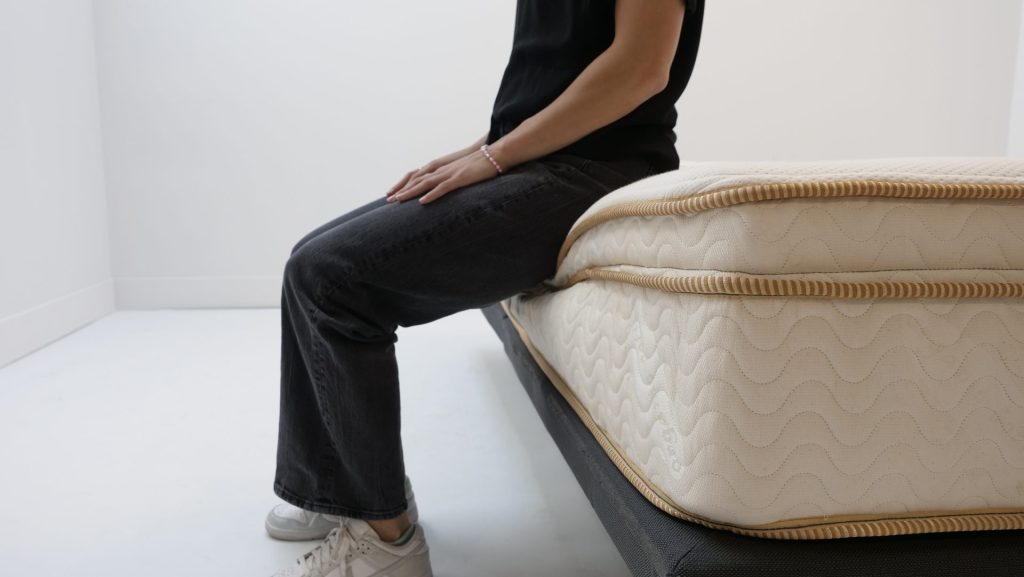
Next is a three-inch layer of Talalay latex and innerspring coils made from recycled steel. Our testers were surprised by the mattress’s firmness when lying on it. Even with the soft mattress cover and bouncy, cushioning latex, testers felt more “on” the mattress than “in” it, leading us to rate the Saatva Latex Hybrid a firm hybrid mattressⓘ Hybrid mattresses combine the features of both innerspring and foam mattresses, with springs surrounded by a thick comfort layer of foam or latex. .
Average-weight sleepers (130–250 pounds) and higher-weight sleepers (more than 250 pounds) should feel excellent support and pressure relief when lying on their backs. The latex and innerspring coil layers have targeted support, meaning they are designed to be firmer or softer in select places to support sleepers. Some of the best mattresses for back pain offer zoned support ⓘ Multiple firmness levels, or “zones,” built into a mattress so it can support different areas of the sleeper’s body in different ways. to help reinforce the lower back area.
If you sleep primarily on your stomach, consider this mattress. Unlike side and back sleepers, pressure relief isn’t the main deciding factor for stomach sleepers. The best firm mattresses for stomach sleepers should be firm enough to support your hips so they don’t sink out of alignment with your spine when lying on your stomach.
Side sleepers need a soft surface their shoulders and hips can sink into while they sleep. Since the Saatva Latex Hybrid is firmer, we don’t recommend this mattress for most side sleepers.

The Saatva Latex Hybrid is the only mattress here that’s not a bed in a box. Bed-in-a-box mattresses arrive compressed, rolled, and sealed in a box, while Saatva mattresses arrive ready to sleep on.
Our mattress expert’s take
Who may love it
- Back and stomach sleepers who need the firm support necessary for proper spinal alignment
- Eco-conscious consumers looking for organic and natural materials
- Sleepers who need a responsive bed with good edge support for easy mobility
Who may want to avoid it
- Side sleepers who need pressure relief for hips and shoulders
- Sleepers looking for a soft, plush mattress
- Shoppers who need white-glove delivery to haul the mattress into the bedroom
Learn more in our Saatva review.
Best Hybrid Mattress for Allergies: Helix Midnight
Our expert take on the Helix Midnight mattress
The Helix Midnight is the only hybrid mattress in our review that contains memory foam instead of natural latex. Since sleepers with a latex allergy shouldn’t come into contact with the material in latex mattresses, we want to include the Helix Midnight as a latex-free option. Memory foam is considered antimicrobial and less hospitable to dust mites since it’s dense and has a closed-cell design. Helix mattresses are CertiPUR-USⓘ and GREENGUARD-certifiedⓘ , meaning they don’t expel certain pollutants and chemicals that may be irritating and harmful to sleepers.

We consider the Helix Midnight a firm mattress with gentle support for back sleepers of any weight. Our testers felt the most comfortable in this position, and the mattress contoured nicely to their lower back area. We think most stomach sleepers’ hips will be adequately supported and lifted on this firm mattress.
The surface was very responsive when our testers switched positions and moved on the mattress. Although the Helix Midnight contains memory foam instead of latex, sleepers will still get the same bouncy, responsive benefits.
This mattress probably isn’t soft enough for lighter-weight sleepers (less than 130 pounds) and average-weight side sleepers, but higher-weight side sleepers should experience nice sinkage in their shoulders and hips. Consider the Helix Midnight Luxe for a more plush, cushioning hybrid mattress with a built-in pillow top.

Our tester on the Helix Midnight Luxe mattress
“I like the Helix Midnight mattress because it offers gentle support when back sleeping, I found this very comfy.”
Our mattress expert’s take
Who may love it
- Sleepers looking for a latex-free hybrid mattress
- Back and stomach sleepers of any weight
- People who need a responsive bed with good edge support for easy mobility
Who may want to avoid it
- Lighter- and average-weight side sleepers
- Sleepers looking for a soft mattress
- Couples who don’t want to wake their partner when switching sides at night
To learn more, read our Helix Midnight Luxe review.
Best Mattress for Allergies and Back Pain: WinkBeds EcoCloud Hybrid
Our expert take on the WinkBeds EcoCloud Hybrid mattress
The WinkBeds EcoCloud Hybrid contains natural, organic materials that may be less irritating for sleepers. The mattress cover is made from organic cotton and New Zealand wool, followed by a four-inch layer of Talalay latex. The mattress is CertiPUR-US and GREENGUARD-certified, meaning the material doesn’t contain certain pollutants and chemicals that may be irritating and harmful to sleepers.
Mattress firmness feels different to every sleeper, but we think the medium-firm WinkBeds EcoCloud Hybrid should support most sleepers. Our testers felt excellent pressure relief and weight distribution when lying on their backs. Sleepers living with back pain may find relief with the mattress’s zoned support. The innerspring coils are firmer or softer depending on their location to target and support different areas of the body. The softer coils in the shoulder area may be comfortable for some side sleepers, but we recommend a softer mattress for lighter-weight side sleepers.
Our testers moved easily on the hybrid mattress due to its responsive latex and innerspring coils. When changing positions, sleepers shouldn’t feel “stuck” or like they’re fighting the material.
Our mattress expert’s take
Who may love it
- People who need a responsive bed with good edge support for easily moving and getting in and out of bed
- Sleepers with lower back pain who benefit from extra support in the lower back area
- People searching for natural materials in their mattresses
Who may want to avoid it
- Sleepers who are easily disturbed by their partner’s movements
- Lighter-weight sleepers who prefer sleeping on their side
- Stomach sleepers of any weight
Read more in our in-depth WinkBed review.
Nolah Natural: Best Mattress for Allergies and Side Sleepers
Our expert take on the Nolah Natural mattress
The mattress cover is made with organic cotton and GOTS-certified wool. These light, breathable materials naturally repel moisture and help prevent bacteria, mildew, and mold growth. Wool is also a natural fire retardant. The mattress cover is followed by two layers of responsive, bouncy Talalay latex and innerspring coils made with recycled steel.
The Nolah Natural mattress contains many of the same hypoallergenic materials as other mattresses in this roundup. Still, it has a softer, cushioning surface, making it one of the best mattresses for side sleepers or anyone looking for a softer mattress.
The material contoured nicely to our testers, while the supportive innerspring coils kept them “on” the mattress instead of sinking into it. Although our testers didn’t sink deeply into the mattress, the plush cover allowed their shoulders and hips to dip comfortably into the surface when lying on their side.
The innerspring coils have three targeted zones to help support the sleeper’s lower back and keep the spine in alignment. We recommend the Nolah Natural for back and side sleepers of any weight, but it’s probably too soft for most stomach sleepers.
Our mattress expert’s take
Who may love it
- Side sleepers who need excellent pressure relief at the hips and shoulders
- People with back pain who benefit from extra support in the lower back area
- People who need a responsive bed with good edge support for easy mobility
Who may want to avoid it
- Sleepers looking for a firmer mattress
- Sleepers who are easily disturbed by their partner’s movements
- Stomach sleepers who need more support
If you want to learn more, read our Nolah mattress review.
Birch Natural: Best Organic Mattress for Allergies
Our expert take on the Birch Natural mattress
Birch holds its mattresses to high manufacturing and material standards. The Birch Natural mattress is GOTS-certified and GREENGUARD Gold-certified, reducing exposure to chemicals and other products that may irritate sleepers with allergies or chemical sensitivities. The mattress contains layers of organic, hypoallergenic materials: an organic cotton mattress cover, wool comfort layer, and eco-INSTITUT-certifiedⓘ Certifies bedding material is low in pollutants and emissions based on rigorous testing. natural latex rest on pocketed innerspring coils designed to support and contour to sleepers. Natural latex helps repel dust mites and prevent microbe buildup.
The latex layer and innerspring coils give the mattress a responsive, bouncy surface that makes it easy to switch positions and move around on. The Birch Natural contoured to our testers and supported their lower backs, offering excellent pressure relief.
This hybrid mattress doesn’t have a plush, deep sinking feeling. It offers contoured, reinforced support that we recommend for back sleepers of any weight and lighter- and average-weight stomach sleepers. If you switch between these two positions at night, the responsive mattress will help guide your movements and make settling into your new position easy.

Although we typically recommend softer mattresses for side sleepers, one tester felt comfortable lying on their side, but their shoulders rested slightly higher than they would have liked. We think higher-weight sleepers will be the most adequately supported compared to lighter- and average-weight sleepers when lying on their side.
Our mattress expert’s take
Who may love it
- People who need a responsive bed with good edge support for easy mobility
- Sleepers searching for natural materials in their mattresses
- Combination sleepers seeking a mattress that’s easy to move around on
Who may want to avoid it
- Lighter-weight sleepers who prefer sleeping on their sides
- Couples who don’t want to wake their partner when switching sides at night
Read our Birch mattress review if you want to learn more.
How we test hypoallergenic mattresses
Our Reviews Team has devoted more than 1,000 hours to researching 40 mattress brands, amounting to 130 different models. We also surveyed more than 3,200 mattress owners about what is most important to them in a new mattress and consulted with 10 healthcare professionals about what features are most important in a hypoallergenic mattress.
Using this information, our team narrowed down the mattresses we researched to the most promising options, then mystery shopped those models before setting them up for first-hand testing. Our testers rely on a 32-page, standardized testing form, which allows them to evaluate each model independently across categories that are important for sleeper comfort. We paid close attention to features that seem to matter most in hypoallergenic options, including materials used, certifications, and off-gassing. Mattresses are then scored across each testing category. Based on those scores, we rate the mattresses in our scorecard and what makes for a good hypoallergenic mattress.
To learn more about our testing, review our sleep methodology.

We continuously test new mattresses each month and make sure we give you the most up-to-date information possible. Each test takes into account mattress features, materials, firmness levels, cost, and other key factors to find the best options on the market.
What is a hypoallergenic mattress?
A hypoallergenic mattress contains fewer allergens and irritants than a standard mattress because of its material and construction. “Hypoallergenic” doesn’t mean a product is 100% free of allergens—it’s simply less likely to cause an allergic reaction or irritation [3] Asthma and Allergy Foundation of America. Hypoallergenic or Allergy Free: Science or Marketing Hype? May 24, 2023. Found on the internet at https://community.aafa.org/blog/hypoallergenic-science-or-marketing-hype .
Who should consider using a hypoallergenic mattress
Since hypoallergenic mattresses prioritize natural materials, they are a great fit for someone who places a value on creating a healthy, chemical-free sleeping environment. If you have environmental allergies or asthma and find you are sensitive to dust mites, mold, and mildew, a hypoallergenic mattress is a good fit for you. Some sleepers find that chemicals used in conventional mattresses are bothersome to them, and would benefit from sleeping on a hypoallergenic, organic option with low off-gassing.
How to choose a hypoallergenic mattress
When choosing the right mattress to help prevent allergies, consider the mattress material, your sleeping position(s), personal preferences, and budget. There’s no “best” mattress for everyone, but our recommendations can help you narrow your choices to find the right hypoallergenic mattress for your lifestyle and budget.
Mattress certifications
If you have environmental allergies or are sensitive to certain chemicals, finding the right hypoallergenic mattress can be an important part of managing your symptoms. Third-party certifications can help guide your search and provide you with confidence that you have chosen a brand that will promote healthy sleep.
- CertiPUR-US: This is a certification given to mattresses containing polyurethane. If a mattress bears this seal, you know the materials are made without heavy metals and that the brand has complied with third-party regulations concerning flame retardants, VOCs, and phthalates.
- Oeko-Tex Standard 100: Earning this seal indicates that the mattress brand has avoided the use of harmful chemicals in the textiles used in mattresses.
- GREENGUARD Gold: Mattresses earning a GREENGUARD Gold certification have followed strict regulations regarding volatile organic compounds (VOCs) that could be harmful to consumer health.
- Global Organic Latex Standard (GOLS): This certification is given to mattresses containing latex that is at least 95% organic. Earning this seal also means the mattress brand has complied with restrictions on harmful chemicals.
Mattress material
A hypoallergenic mattress may be a hybrid, innerspring, memory foam, or latex model. Here’s how to tell the difference between these mattress designs.
- Hybrid mattresses: This style of mattress combines an inner core with layers of memory foam. The best hybrid mattresses balance support with cushioning and pressure relief for a comfortable sleep experience.
- Innerspring mattresses: This classic mattress design uses innerspring coils that are either individually pocketed or arranged in layers for a supportive and responsive mattress. Learn more about our picks for the best innerspring mattresses.
- Memory foam mattresses: Using layers of support and memory foam, the best memory foam mattresses are responsive to body heat and contour to the curves of the sleeper’s body while still maintaining a neutral spine. Memory foam has a dense structure less hospitable to dust mites, dust, and pet dander than innerspring mattresses.
- Latex mattresses: Latex foam is an alternative to polyurethane foam that is naturally derived from rubber trees. Like memory foam, latex is less likely to house dust mites, dust, and pet dander. Learn more about our pick for the best latex mattress.
Sleep accessories
Remember that your hypoallergenic mattress will be more effective when paired with allergy-friendly bed sheets and pillows. Choose bed sheets containing natural, hypoallergenic materials and foam or latex pillows. Avoid down-filled pillows and comforters since down feathers may cause an allergic reaction. If you are looking for a new pillow, read our review of the best pillows.
There aren’t federal regulations for hypoallergenic products, but the Asthma and Allergy Foundation of America (AAFA) and Allergy Standards Limited (ASL) have created an asthma and allergy-friendly certification for everyday household products, including bedding.
Mattress firmness
Firmness doesn’t affect a mattress’s protection against allergens, but you’ll need the right firmness to comfortably support your sleeping position, body weight, and personal preferences. Generally, a medium mattress accommodates most sleepers, but depending on your needs, you may need a softer or firmer mattress.
We recommend a softer, more cushioning mattress for side sleepers. The soft surface helps relieve pressure in the shoulders and hips. Stomach sleepers usually need a firmer mattress to prevent their hips from sinking into the mattress and out of alignment with their spine. Firm mattresses are often the best mattresses for higher-weight people since they offer reinforced support without too much sinkage.
Price
Determine your budget when shopping for a hypoallergenic mattress. Mattresses are an investment, especially since we spend a third of our lives sleeping [4] National Institute of Neurological Disorders and Stroke. Brain Basics: Understanding Sleep. Found on the internet at https://www.ninds.nih.gov/health-information/public-education/brain-basics/brain-basics-understanding-sleep . Still, many high-quality, affordable mattresses are available to accommodate different budgets.
Generally, hybrids and latex mattresses are more expensive (about $1,500–$2,200 for a queen) compared to foam and innerspring mattresses (about $700–$1,200 for a queen). All mattresses in this review include free shipping. Some mattress brands offer white-glove delivery for an additional fee, which may include mattress setup, old mattress removal, or both.
When comparing mattress prices, also compare each brand’s trial period, return policy, and warranty.
How much do hypoallergenic mattresses cost?
Our choices for the best hypoallergenic mattresses cost as little as $1,332 or as much as $2,395 for a queen-sized bed. The price can vary based on the size of the mattress chosen and the materials used during construction. In general, you will find that hypoallergenic options cost a little more than a conventional option, but there are many budget-friendly choices, including the Helix Midnight mattress mentioned above. It is also true that most online brands offer discounts on their mattresses and that there are various ways to save money on a hypoallergenic mattress.
How to save money on a hypoallergenic mattress
Mattress brands usually offer discounts throughout the year, with the best promotions running during holidays like President’s Day, Memorial Day, Fourth of July, Labor Day, Veterans Day, Black Friday, and Cyber Monday.
Many brands also offer discounts for military members, first responders, health care workers, and educators, but these discounts usually cannot be combined with other discounts.
Compare the best hypoallergenic mattresses as of 2025
| Mattress type | Hybrid | Hybrid | Hybrid | Hybrid | Hybrid |
| Mattress height | 12 inches | 11.5 inches | 12.5 inches | 11 inches | 11 inches |
| Warranty | Lifetime | 10 years | Lifetime | Lifetime | 25 years |
| Material | Organic cotton, natural latex, recycled steel coils | Memory foam, steel coils | Organic cotton, wool, Talalay latex, recycled steel coils | Organic cotton, wool, Talalay latex, recycled steel coils | Organic cotton, wool, natural latex, steel coils |
Bottom line
A hypoallergenic mattress isn’t completely free from allergens, but some mattresses may be more allergy-friendly than others. We recommend the Saatva Latex Hybrid as the best hypoallergenic mattress. The mattress contains natural, organic materials and botanical antimicrobial treatment. Saatva also offers customer-friendly policies such as a one-year trial period, free white-glove delivery, and a lifetime warranty.
We also recommend the Helix Midnight, WinkBed EcoCloud, Nolah Natural, and Birch Natural. There’s no one-size-fits-all mattress, so consider your sleeping position, budget, and personal preferences when shopping for an allergy-friendly mattress.

Frequently asked questions
If you have allergies, we recommend avoiding traditional innerspring mattresses. These mattresses have a more open structure than hybrid or foam mattresses, which may make it easier for dust mites, pet dander, and other allergens to settle in. Down-filled and foam mattresses with synthetic materials may also irritate sleepers with allergies or chemical sensitivities. Look for CertiPUR-US- and GREENGUARD-certified mattresses when shopping for hypoallergenic mattresses. Contact the manufacturer if you want to know more about a mattress brand’s materials and manufacturing practices.
Over time, allergens like dust mites, mold, and mildew may build up in your mattress. These allergens can cause frequent sneezing, coughing, congestion, watery eyes, or a running nose. Hypoallergenic mattresses contain natural and synthetic materials designed to deter allergens.
The best mattress for allergies varies for each sleeper, but memory foam or latex mattresses are generally recommended. Memory foam and latex are antimicrobial, and the dense materials are less likely to attract and gather dust, bacterial growth, dust mites, and pet dander than innerspring mattresses.
Most latex mattresses are safely encased in a mattress cover and shouldn’t irritate sleepers with a latex allergy, but those with latex allergies should still be cautious when shopping for a mattress.
A memory foam mattress can be good for allergies because it’s naturally antimicrobial. Memory foam’s dense structure makes it difficult for bacteria, mildew, mold, and other microorganisms to grow and thrive in the material. Some memory foam mattresses contain polyurethane, a petroleum product that may aggravate allergies. Look for certifications like CertiPUR-US and GREENGUARD when shopping for a memory foam mattress.
A removable mattress cover isn’t guaranteed to make your mattress more allergy-friendly. Consider a hypoallergenic mattress containing natural and synthetic materials designed to repel allergens. Our top allergy-friendly mattresses are the Saatva Hybrid Latex, Helix Midnight, WinkBed EcoCloud, Nolah Natural, and Birch Natural.
Have questions about this article? Email us at reviewsteam@ncoa.org.
Sources
- Centers for Disease Control and Prevention. Most Recent National Asthma Data. May 10, 2023. Found on the internet at https://www.cdc.gov/asthma/most_recent_national_asthma_data.htm
- Latex Allergy. Asthma & Allergy Foundation of America. April 19, 2024. Found on the internet at aafa.org/allergies/types-of-allergies/latex-allergy
- Asthma and Allergy Foundation of America. Hypoallergenic or Allergy Free: Science or Marketing Hype? May 24, 2023. Found on the internet at https://community.aafa.org/blog/hypoallergenic-science-or-marketing-hype
- National Institute of Neurological Disorders and Stroke. Brain Basics: Understanding Sleep. Found on the internet at https://www.ninds.nih.gov/health-information/public-education/brain-basics/brain-basics-understanding-sleep








